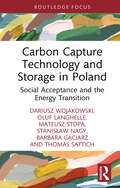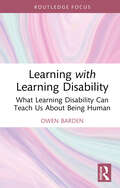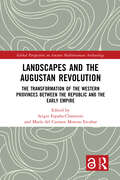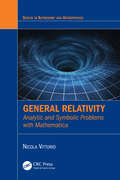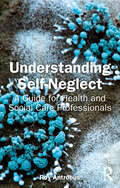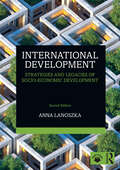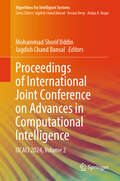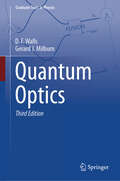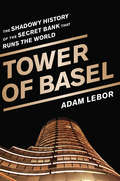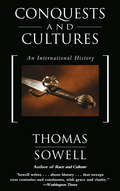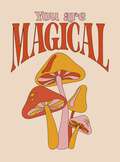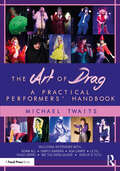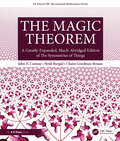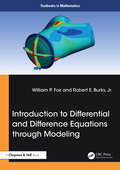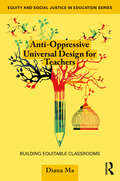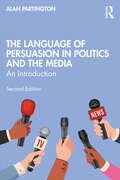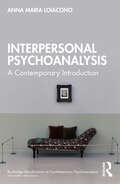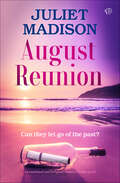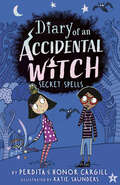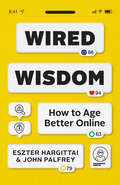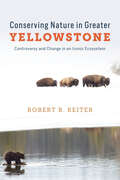- Table View
- List View
Carbon Capture Technology and Storage in Poland: Social Acceptance and the Energy Transition (Routledge Focus on Energy Studies)
by Oluf Langhelle Dariusz Wojakowski Mateusz Stopa Stanisław Nagy Barbara Gąciarz Thomas Michael SattichThe book describes the results of the AGaStor Project’s social research carried out in northwestern Poland which recognizes the main social opportunities and barriers to the introduction of CCUS to society.At the national and regional level, the social barriers of CCUS acceptance are ignorance, uncertainty and the lack of public debate about this technology. On the local scale, social acceptance depends on the needs and fears of the local community. Some of those fears – distrust and perception of CO2 as a waste – could be recognized as universal dilemmas connected with CCUS. Although as knowledge about CCUS increases, a significant change in attitude can be observed. This change does not mean an acceptance of that technology. It is rather a shift towards more benign forms of resistance – from NIMBY to WIMBY. The book presents actual mechanisms of social reaction to UGS and CCUS investment, which will be a valuable contribution to managing social change in the context of green transition.The issue of social acceptance of CCUS should be of interest to decision makers and practitioners who manage investment projects in the broadly understood green transformation on a daily basis, and also to postgraduate students, researchers, academics and lecturers in political studies, sociology or economics, and in engineering studies connected with energy transformation.
Learning with Learning Disability: What Learning Disability Can Teach Us About Being Human (Autocritical Disability Studies)
by Owen BardenThis book uses the concept of “learning disability” to explore what it means to be human. It argues that we need to learn with rather than from or about learning disability. This crucial distinction means being open to what learning disability can teach us about what it means to be human. This approach comes from recognising learning disability as an organising concept – a concept which radically transforms our sense of what it means to be – or not be – a person.After reflecting on the author’s relationship to learning disability, the book explores relationships and tensions between conceptualisations of learning disability and of the human. Through historical ontology, the book initially examines how the phenomenon of “learning disability” came into being. It then explores ways in which the concept of learning disability has, over the course of the 20th and 21st centuries, radically transformed our sense not only of education and learning, but also of who is or is not deemed entitled to full citizenship and the associated rights, and so who is or is not fully human. Each chapter of the book exposes tensions and contradictions apparent in the ways we tend to think about personhood and learning disability, illuminating them through a series a binary oppositions: human and not fully human; menacing and vulnerable; controlled and abandoned; capable and incapable; human and posthuman.The book concludes by drawing together these tensions and contradictions to challenge the prevailing metanarrative of disability and make the case for a more inclusive conceptualisation of what it means to be human.It will be of interest to all scholars and students of disability studies, the history of learning disability, humanism and posthumanism, and learning disability advocacy.
Landscapes and the Augustan Revolution: The Transformation of the Western Provinces between the Republic and the Early Empire (Global Perspectives on Ancient Mediterranean Archaeology)
by Sergio España-ChamorroThis book centres on the transformation of landscapes, focusing on the Western Mediterranean during the end of the Roman Republic and the Early Roman Empire.This volume brings together diverse contributions that utilise both theoretical and practical approaches from landscape studies and archaeology to examine the transitions to the Empire in the provincial landscapes of the western Roman Empire. Focusing on wider processes of change and continuity, identified through diverse approaches (e.g., settlement patterns, mobility and communication, and military expansion) and methods (e.g., spatial analysis, remote sensing, and GIS), the contributions highlight the profound socio-economic, political, and environmental factors whose interplay shaped the region. In doing so, the book underscores the agency of local communities in shaping their landscapes and their varied responses to Imperial policies, thus generating new insights into the processes of social and political change brought about by Augustan reforms and how these were implemented and experienced at the local level.This book will be of interest to students and researchers of archaeology and ancient history, particularly those focused on Roman and landscape archaeology.
General Relativity: Analytic and Symbolic Problems with Mathematica (Series in Astronomy and Astrophysics)
by Nicola VittorioThis book provides General Relativity problems to be tackled both analytically and symbolically-numerically with the Mathematica software. In the first case, the reader is guided in setting up the appropriate solutions. In the second case, the reader is provided with very illustrative notebooks to carry out the steps necessary to solve a General Relativity problem. These include the calculation of the Christoffel symbols, Riemann, Ricci, Einstein and energy-momentum tensors, as well as the resolution of the field equations of General Relativity in different astrophysical/cosmological contexts, with and without the introduction of a cosmological constant. This study guide should be used alongside existing textbooks to provide additional learning and engagement opportunities for advanced undergraduate and graduate students in physics and astrophysics taking courses on general relativity. It may also be of interest to mathematics students interested in celestial mechanics and space sciences.A number of the Mathematica codes used in this book can be accessed online here; [INSERT URL WHEN AVAILABLE]Key Features:• Promotes the "learning by doing" approach, guiding the student in the building of the mathematical apparatus necessary to solve problems in General Relativity.• Encourages the development of analytical skills to address and solve specific and challenging problems in General Relativity.• Develops symbolic-numerical skills to address problems (often already solved analytically) so that the reader is prepared to attack even more elaborate calculations in General Relativity.
Understanding Self-Neglect: A Guide for Health and Social Care Professionals
by Roy AntrobusThis book will assist health and social care professionals to improve and open up further awareness of the characteristics of self-neglect.The perspectives of professionals and public, associated policy, legal and practice is presented in a relevant and accessible format. By taking the reader on a series of self-neglecting journeys from past to present, it explores conversations, both between professionals and members of the public. At any given time, anyone could be assessed as self-neglecting and thus becoming a self-neglecter. The aim and expectation seeks to enable the reader to get closer to this health and social care category. Human rights issues, the ‘best practice’ principles around personalization and capacity, reflection on interventions, and an alternative care model will all be discussed and analysed. The inclusion of a case-study (vignette) with open-ended questions and prompts, offers the reader a valuable opportunity to ‘get’ involved and can be used individually, peer-support (group), for Continued Professional Development (CPD) or in educations settings.Offering an honest, open and thought provoking means to get closer to a subject matter which can often be viewed with bewilderment, unease and complexity as to how situations have come about, have been allowed to continue and what action needs to be taken.The content covers a wide range of material, and will be of interest to all professionals in health and social care as well as legal professionals, institutions (governing), and environmental health and housing officers.
International Development: Strategies and Legacies of Socio-Economic Development
by Anna LanoszkaInternational Development: Strategies and Legacies of Socio-Economic Development examines the multifaceted challenges and strategies underlying socio-economic progress in a globally interconnected world.Grounded in a thorough historical and theoretical framework, this book explores the evolution of developmental strategies, from post-colonial challenges, the growing influence of international organizations, and the role of state policies to the impacts of global market integration and demands for environmental sustainability. It scrutinizes the effectiveness of international organizations and foreign aid agencies, the resilience of local strategies, and the persistent disparities shaped by historical legacies, extractive and inclusive state institutions, deficit of individual rights, systemic poverty, gender inequality, armed conflicts, environmental hazards, and food insecurity. Through case studies and document-driven insights, it highlights the intersection of institutional frameworks, economic imperatives, and human agency in shaping developmental outcomes. By integrating environmental and sustainability considerations with economic strategies, the book underscores the necessity of inclusive policies that address structural barriers and promote human-centered development. This new edition has been thoroughly updated to include material on decolonization, the various effects of the Covid-19 pandemic, gender and sexual orientation-based discrimination, climate change, migration, and economic insecurity.With a multi-disciplinary approach taking into account politics, international relations, economics, sociology, cultural studies, and the history of development, this book is an invaluable resource for students and scholars, as well as policy makers and practitioners working and researching in those fields.
Proceedings of International Joint Conference on Advances in Computational Intelligence: IJCACI 2024, Volume 2 (Algorithms for Intelligent Systems)
by Jagdish Chand Bansal Mohammad Shorif UddinThis book gathers outstanding research papers presented at the 8th International Joint Conference on Advances in Computational Intelligence (IJCACI 2024), held in hybrid mode at South Asian University, New Delhi, India, during October 5–6, 2024. IJCACI 2024 is jointly organized by Jahangirnagar University (JU), Bangladesh, and South Asian University (SAU), India. The book presents the novel contributions in areas of computational intelligence, and it serves as a reference material for advance research. The topics covered are collective intelligence, soft computing, optimization, cloud computing, machine learning, intelligent software, robotics, data science, data security, big data analytics, and signal and natural language processing.
Physics and Mechanics of New Materials and Their Applications: Proceedings of the International Conference PHENMA 2024 (Springer Proceedings in Materials #3)
by Shun-Hsyung Chang Ivan A. Parinov Vijay Kumar Gupta Nagendra SohaniThe book provides new results of internationally recognized scientific teams in the fields of Materials Science, Physics, Mechanics, Fabrication Techniques and Technologies of Advanced Materials, operating in wide scaling from nanometer to macroscopic range. The developed theoretical and experiment approaches cover prospective manufacture methods of nanomaterials, ferroelectrics, piezoelectrics (environmentally friendly) and other advanced materials and composites. The book discusses fabrication techniques, physics, mechanics, and applications of promising materials and composites. It presents numerous results of theoretical and experimental studies of novel materials and devices with beforehand given and improved structure-sensitive properties, based on the methods of biology, inorganic and organic chemistry, magnetoelectric elasticity, physics of condensed matter and material science. Thus, the book allows one to better understand the modern requirements for advanced materials and composites. The results obtained also include computational algorithms and original hard- and software, used in realization of numerical methods (in particular, finite-element modeling), demonstrating fascinating new advancements for wide spectrum of novel materials (which could be obtained due to reprocessing or using natural materials, wastes, fruits and plants) and devices. The advanced materials with specific properties and novel devices, based on them, show higher and improved properties in comparison with the properties of the competitive publications. In the result, it gives a new knowledge, which is necessary for numerous applications and subsequent development of industry and the methods of management and marketing. The original theoretical, numerical and experiment methods, manufactured devices and set-ups demonstrate significant possibilities in expanding the research of various physical processes and phenomena. They provide different improvements in the study of numerous structure-sensitive characteristics of solids and structures. The book will be useful for students, post-graduate students, scientists and engineers, which research and develop a new generation of nanomaterials and nanocomposites, ferroelectric and piezoelectric materials, other promising structures and compositions with structure-sensitive properties, and various devices, designed on their base and used in different applications of science, technique and technology. Moreover, it will be very interesting for specialists, working in industry, management and marketing. The book is important for unification and development of various expertise, designs and studies. It presents new research methods and scientific results in the Condensed Matter Physics, Materials Science, Physical and Mechanical Experiment, Processing Techniques and Engineering of Nanomaterials, Piezoelectrics and other Advanced Materials and Composites, Computational Methods, numerous applications and developed devices.
Quantum Optics (Graduate Texts in Physics)
by Gerard J. Milburn D. F. WallsThis graduate textbook unifies the presentation of new and well-established basic theory and experiments for the quantum properties of light. Quantum optics has become a major field of theoretical and experimental physics. Many of the key tests of unique quantum phenomena, such as entanglement, have been demonstrated in quantum optics experiments. It forms the basis of many quantum technologies from sensing to computation. This completely revised third edition enables graduate students to acquire a deep knowledge of contemporary quantum optics and its relevance for quantum technology. New experimental developments are discussed, alongside the relevant theory. New chapters on quantum control, quantum opto-mechanics, quantum communication and computation have been added. Numerous exercises help readers test their understanding and provide practice in quantitative problem solving.
Tower of Basel: The Shadowy History of the Secret Bank that Runs the World
by Adam LeBor&“An absorbing and thorough examination&” of the Bank for International Settlements, &“one of the world&’s most important yet opaque institutions&” (Reuters)Tower of Basel is the first investigative history of the world's most secretive global financial institution. Based on extensive archival research in Switzerland, Britain, and the United States, and in-depth interviews with key decision-makers -- including Paul Volcker, the former chairman of the US Federal Reserve; Sir Mervyn King, governor of the Bank of England; and former senior Bank for International Settlements managers and officials -- Tower of Basel tells the inside story of the Bank for International Settlements (BIS): the central bankers' own bank. Created by the governors of the Bank of England and the Reichsbank in 1930, and protected by an international treaty, the BIS and its assets are legally beyond the reach of any government or jurisdiction. The bank is untouchable. Swiss authorities have no jurisdiction over the bank or its premises. The BIS has just 140 customers but made tax-free profits of 1.17 billion in 2011-2012. Since its creation, the bank has been at the heart of global events but has often gone unnoticed. Under Thomas McKittrick, the bank's American president from 1940-1946, the BIS was open for business throughout the Second World War. The BIS accepted looted Nazi gold, conducted foreign exchange deals for the Reichsbank, and was used by both the Allies and the Axis powers as a secret contact point to keep the channels of international finance open. After 1945 the BIS -- still behind the scenes -- for decades provided the necessary technical and administrative support for the trans-European currency project, from the first attempts to harmonize exchange rates in the late 1940s to the launch of the Euro in 2002. It now stands at the center of efforts to build a new global financial and regulatory architecture, once again proving that it has the power to shape the financial rules of our world. Yet despite its pivotal role in the financial and political history of the last century and during the economic current crisis, the BIS has remained largely unknown -- until now.
Conquests and Cultures: An International History
by Thomas SowellThis book is the culmination of 15 years of research and travels that have taken the author completely around the world twice, as well as on other travels in the Mediterranean, the Baltic, and around the Pacific rim. Its purpose has been to try to understand the role of cultural differences within nations and between nations, today and over centuries of history, in shaping the economic and social fates of peoples and of whole civilizations. Focusing on four major cultural areas(that of the British, the Africans (including the African diaspora), the Slavs of Eastern Europe, and the indigenous peoples of the Western Hemisphere -- Conquests and Cultures reveals patterns that encompass not only these peoples but others and help explain the role of cultural evolution in economic, social, and political development.
You Are Magical: Empowering Quotes and Affirmations to Lift Your Vibe
by Summersdale PublishersEmbrace your brilliance with this treasure trove of energizing quotes, sound advice and inspiring affirmations. The powerful dose of positive energy and feel-good vibes inside this little book will help boost your confidence, supercharge your mood and bring some sunshine into your day.
Intelligent Systems of Computing and Informatics in Sustainable Urban Development
by Samsul Ariffin Abdul Karim and Aslina BaharumThis book explores intelligent systems in computing and informatics, focusing specifically on their role in advancing Sustainable Development Goal (SDG) No. 11 – Sustainable Cities and Communities.SDG 11 is part of the 17 Sustainable Development Goals adopted by the United Nations in 2015. From innovative urban planning to efficient resource management and enhanced community well-being, the book navigates through the multifaceted applications of intelligent systems in the pursuit of sustainable urban development. By emphasizing practical insights, readers gain actionable knowledge to apply the concepts in diverse urban contexts. The authors provide a holistic perspective on the integration of intelligent systems within the context of SDG No. 11.The book comprehensively explores the intersection of computing, informatics, and sustainable urban development. Real-world examples and case studies are used to illustrate the successful implementation of intelligent systems in creating sustainable cities. Readers will learn about the integration of computing technologies and informatics in urban environments, aiming to create smarter, resilient, and sustainable cities. With the ever-evolving nature of technology and urban development, this book delves into the latest advancements in intelligent systems, ensuring that readers are equipped with insights into cutting-edge technologies and their potential impact on sustainable cities. A multidimensional approach using computing, informatics, urban planning, and sustainability studies facilitates a more comprehensive understanding of the challenges and opportunities in creating intelligent, sustainable urban environments.Practitioners in urban planning, technology, and related fields can utilize this book as a practical guide for implementing intelligent systems and best practices in making informed decisions. Researchers can also leverage the comprehensive coverage of the topic to inform and substantiate their own studies and investigations.
The Art of Drag: A Practical Performers’ Handbook
by Michael TwaitsThe Art of Drag: A Practical Performers’ Handbook is the ultimate guide for all drag kings, queens and queers who want to bring their best to the stage.Filled with a wide range of exercises and advice from working performers, this book is a guide and support for every working drag act, but also the drag-curious wanting to step a sequinned toe onto the stage for the first time. The book focuses on practical performance advice for creating new work, refining existing work and exploring new skills and perspectives from the world of drag. It also includes: Practical performance tips demystifying live performance skills such as singing, lip-sync, impersonation and comedy. Top tips on how to get bookings, get paid and make a profit. Advice on how to communicate with an audience and create an unforgettable live experience. Interviews with seven sensational acts who discuss how they use the art of drag: Adam All, Simply Barbra, Ada Campe, Hugo Grrrl, Le Fil, Me the Drag Queen and Son of a Tutu. Written by a drag act, for drag acts, The Art of Drag is an invaluable resource for new and aspiring drag performers, along with academic performance courses covering Drag, Cabaret, or Queer Performance.
Friedrich Schleiermacher’s Philosophy of Religion: Historical and Contemporary Perspectives (Routledge Studies in the Philosophy of Religion)
by Stefan Lang Klaus ViertbauerThis volume provides a comprehensive account of Friedrich Schleiermacher’s philosophy of religion. The contributors cover the historical context of Schleiermacher’s work, specific aspects of his philosophy of religion, and the ways that his work can contribute to contemporary debates.Friedrich Schleiermacher is considered one of the outstanding representatives of 19th‑century Protestant theology. This volume brings together scholars from both continental and analytic traditions to explore Schleiermacher’s preeminent role in post‑Kantian philosophy of religion. The chapters are divided into three thematic sections. The first section situates Schleiermacher in the context of the 18th- and 19th‑century philosophy of religion. These chapters analyze his relation to thinkers such as Kant, Fichte, Hegel, Schelling, and also to Kierkegaard and Heidegger, as well as to prominent theologians in the Protestant and Catholic traditions. The second section explores different aspects of Schleiermacher’s philosophy of religion such as absolute dependence or religious feeling. Finally, the third section addresses how Schleiermacher’s insights can contribute to contemporary philosophy of religion. These chapters address current debates, particularly on religious experience, feminism, and philosophy of emotions.Friedrich Schleiermacher’s Philosophy of Religion will be of interest to scholars and advanced students working in philosophy of religion, history of philosophy, and 19th‑century religious thought.
The Magic Theorem: A Greatly-Expanded, Much-Abridged Edition of The Symmetries of Things (AK Peters/CRC Recreational Mathematics Series)
by John H. Conway Heidi Burgiel Chaim Goodman-StraussThe Magic Theorem: a Greatly-Expanded, Much-Abridged Edition of The Symmetries of Things presents a wonder- fully unique re-imagining of the classic book, The Symmetries of Things. Begun as a standard second edition by the original author team, it changed in scope following the passing of John Conway. This version of the book fulfills the original vision for the project: an elementary introduction to the orbifold signature notation and the theory behind it.The Magic Theorem features all the material contained in Part I of The Symmetries of Things, now redesigned and even more lavishly illustrated, along with new and engaging material suitable for a novice audience. This new book includes hands-on symmetry activities for the home or classroom and an online repository of teaching materials.
Consulting In Sport Psychology: Perspectives, Opportunities, and Practice Development
by Charles A. MaherThis important book provides practical and immediately applicable information about consulting in sport psychology in an accessible, step-by-step manner, focusing on lessons based on individual, team, and organizational levels.Evidence-based information and real-world sport psychology consulting experiences are detailed to enable practitioners to place sport psychology consulting in practical perspectives, identify meaningful and needed opportunities to engage in, and incorporate sport psychology consulting into their professional practices. Each chapter includes viewpoints, methods, procedures, and illustrations, and end-of-chapter exercises which challenge the practitioner to grow as a sport psychology consultant.Intended for practitioners and graduate students of sport psychology, as well as other professionals who consult about the mental aspect of sport and organizational performance, the book provides an authentic guide to consulting and practice development.
Introduction to Differential and Difference Equations through Modeling (Textbooks in Mathematics)
by William P. Fox Robert E. Burks, Jr.This book presents an opportunity to learn difference and differential equations through a modeling-first approach. The text is meant as an introduction to those equations and not as a text only for modeling courses. No previous exposure to these equations is expected. Modeling in Introduction to Differential and Difference Equations through Modeling is presented as the vehicle for learning difference and differential equations. Although the topics in difference and differential equations are consistent with those in other textbooks, this approach differs. The presentation starts with a model (or several models) and offers the solution with minor discussions. Then, methods to obtain those solutions are presented and show these same models and others again in more detail.This approach is designed to focus on the use of difference and differential equations to solve real-world problems, and to learn not only these primary topics, but how to apply these through modeling.The authors begin with a review of matrix algebra, then an introduction to modeling. The text progresses to discrete dynamical systems, and then to the standard organization of most differential equation texts, making the alignment with a current syllabus easier. Technology is a significant modeling component. Excel®, Python®, and Maple® are presented as methods to solving the models. This material has been class tested at the US Military Academy at West Point, Marian University, the College of William & Mary, and the Naval Postgraduate School with great success.
Anti-Oppressive Universal Design for Teachers: Building Equitable Classrooms (Equity and Social Justice in Education Series)
by Diana MaAnti-Oppressive Universal Design for Teachers: Building Equitable Classrooms provides a student-centered, culturally responsive blueprint for building sustainable and just educational practices. Marginalized students face complex educational barriers, and undoing educational injustice requires intentional practices designed to be explicitly anti-oppressive. Yet schools continue to adopt trendy “one size fits all” practices that benefit only some. This is not equity.Author Diana Ma presents a framework that takes the principles of equity and humanizing pedagogy from anti-oppressive theories and the principles of multiplicity and flexible design from Universal Design for Learning (UDL). Together, these principles form a framework designed to dismantle specific systemic oppression. The Anti-Oppressive Universal Design framework is designed for educators who want to build practices that work for all students.The book’s flexible design tools will help teachers create anti-oppressive and equitable education that frees students to be their full authentic selves in the classroom. In addition, there are classroom strategies and stories to show how this model benefits both students and teachers, providing sustainable alternatives to prescriptive practices.
The Language of Persuasion in Politics and the Media: An Introduction
by Alan PartingtonThis bestselling introductory textbook examines the relationship between politicians, the press and the public through the language they employ. Now fully revised with new material on delegitimisation, ‘fake news’, disinformation, (self-)censorship, ‘conspiracy theories’ and ‘Zombie’ narratives, key topics include:• Evaluation, the ‘engine’ of persuasion.• ‘Spin’, ‘spin control’ and ‘image’ politics.• Models of persuasion, including authority, contrast, problem-solution, association, ‘garden path.’• Pseudo-logical and ‘post-truth’ arguments.• Humour, irony and satire.• Metaphors: use, misuse and dangers.• Election rhetoric.Extracts from speeches, soundbites, newspapers and blogs, social media, interviews, press conferences, election slogans and satires are used to provide the reader with the tools to discover the beliefs, character and hidden strategies of the would-be persuader, as well as the counter-strategies of their targets. This book demonstrates how the study of language use can help us appreciate, exploit and protect ourselves from the art of persuasion.With a wide variety of practical examples, on both recent issues and historically significant ones, every topic is complemented with guiding tasks, queries and exercises, with keys and commentaries at the end of each unit. This highly original textbook is ideal for all introductory courses on language and politics, media language, rhetoric and persuasion, discourse studies and related areas.
Interpersonal Psychoanalysis: A Contemporary Introduction (Routledge Introductions to Contemporary Psychoanalysis)
by Anna Maria LoiaconoIn this book, Anna Maria Loiacono introduces the reader to the origins of Interpersonal Psychoanalysis, its most important concepts, and their clinical value.Throughout the chapters, Loiacono navigates historically through the principles of Harry Stack Sullivan, clearly and succinctly outlining the ideas of those thinkers who followed, to the latest reflections of Contemporary Interpersonal Psychoanalysis. Illustrated with case vignettes, this book addresses concepts such as dissociation, differences between splitting and dissociation, countertransference, enactments, field theory, hermeneutics, the unconscious, the unformulated experience, self-disclosure, relational and interpersonal psychoanalysis, change and the use of the therapist’s subjectivity, as they are currently considered in the interpersonal approach, seen from the perspective of Loiacono’s personal point of view and professional experience.Part of the Routledge Introductions to Contemporary Psychoanalysis series, this book is a vital read for all analysts in practice and training, as well as psychologists and psychiatrists.
August Reunion (Tarrin’s Bay)
by Juliet MadisonSome love stories take a lifetime to find their way home. The bestselling author of Holiday in July returns to Tarrin&’s Bay. After her divorce, Katy McKenzie promised herself she&’d wait a year before dating again. But just when she does, her troubled twin brother shows up needing help, and Katy&’s newfound freedom is put on hold. At her high school reunion, Katy reconnects with Dan Dexter, her childhood best friend and the boy whose romantic confession she once rejected. Now a famous relationship coach, Dan has never forgotten Katy. As they spend time together, old feelings resurface, but their futures may be too different to ever align. With her heart pulled in two directions, Katy must decide whether love is worth the risk and if some second chances are meant to last forever.Heartfelt, emotional, and uplifting, August Reunion is a story about second chances, the strength of family, and finding the courage to follow your heart.
Secret Spells (Diary of an Accidental Witch)
by Honor Cargill Perdita CargillEveryone at the Extraordinary School is excited for the Winter Solstice Grand Tournament—especially Bea! But this year's tournament will be different: Extraordinary will compete against Spellshire Academy, and there's no magic allowed! Who will emerge victorious? And will Bea's friendship with her best non-witchy friend, Ash, survive the competition?Everyone at the Extraordinary Academy is excited for the Winter Solstice Grand Tournament, especially Bea! She&’s been practicing extra-hard and is ready to rise to the challenge. But then Ms. Sparks decides that this year&’s competition will be different—there won&’t be any magic allowed! It will be a regular sports day, and the students at Extraordinary will compete against non-magic school Spellshire Academy. With magic firmly forbidden, which school will emerge victorious? And will Bea&’s friendship with her non-witch best friend, Ash, survive the competition? With black-and-white illustrations throughout. Told through Bea's diary entries, the Diary of an Accidental Witch series invites readers to follow Bea on a humorous journey of self-discovery as she learns where she truly belongs.
Wired Wisdom: How to Age Better Online
by Eszter Hargittai John PalfreyA surprising window into the online lives of people sixty and over—offering essential insights, no matter your age. Many popular accounts say the older you are, the greater your tech struggles. And it’s worrying to think of loved ones emailing cringe-worthy misinformation, falling for phishing attacks, or becoming lonelier with increasing time spent online. But in their eye-opening book on the internet’s fastest-growing demographic, researchers Eszter Hargittai and John Palfrey offer a more nuanced picture—debunking common myths about older adults’ internet use to offer hope and a necessary call to action. Incorporating original interviews and survey results from thousands of people sixty and over, Wired Wisdom shows that many, in fact, use technology in ways that put younger peers to shame. Over-sixties are often nimble online and quicker to abandon social media platforms that don’t meet their needs. Despite being targeted more often, they also may be less likely to fall for scams than younger peers. And fake news actually fools fewer people over sixty, who have far more experience evaluating sources and detecting propaganda. Still, there are unseen risks and missed opportunities for this group. Hargittai and Palfrey offer practical advice and show that our stereotypes can be hurdles that keep us from building intergenerational support communities, helping loved ones adopt new technology that may improve their lives, and thriving together online.
Conserving Nature in Greater Yellowstone: Controversy and Change in an Iconic Ecosystem
by Robert B. KeiterThe story of how Yellowstone, established in 1872 as the world’s first national park, has become synonymous with nature conservation—and an examination of today’s challenges to preserve the region’s wilderness heritage. For more than 150 years, the Yellowstone region—now widely known as the twenty-three million acre Greater Yellowstone Ecosystem—has played a prominent role in the United States’ nature conservation agenda. In this book, Robert B. Keiter, an award-winning public land law and policy expert, traces the evolution and application of fundamental ecological conservation concepts tied to Yellowstone. Keiter’s book highlights both the conservation successes and controversies connected with this storied region, which has been enmeshed in change. During the 1980s, leaders in Yellowstone embraced ecosystem management concepts to recover a dwindling grizzly bear population and to support wolf reintroduction. Since then, management policies in the region’s two national parks and adjacent national forests have largely followed suit, prioritizing ecosystem-level conservation over industrial activity. Groundbreaking efforts are currently afoot to protect elk, deer, and pronghorn migration corridors and to maintain the park’s bison population, effectively expanding the scope of regional conservation initiatives. But in the face of explosive human population growth and related development pressures, new efforts must also account for the region’s privately owned lands along with accelerating recreational activities that present quite different problems. Indeed, the Greater Yellowstone Ecosystem—extending across three states and twenty counties and embracing more than sixteen million acres of federal land as well as private and tribal lands —can only be characterized as a complex, jurisdictionally fragmented landscape. As Keiter makes clear, the quest for common ground among federal land managers, state officials, local communities, conservationists, ranchers, Indigenous tribes, and others is a vital, enduring task. Exploring both notable conservation accomplishments and the ongoing challenges confronting this special place, Keiter’s book explains the many forces—scientific, political, economic, legal, cultural, climatic, and more—at work driving controversy and change across the region. But more than this, Conserving Nature in Greater Yellowstone shows us that the lessons gleaned from Yellowstone’s expansive nature conservation efforts are profoundly important for both the country and the world.
